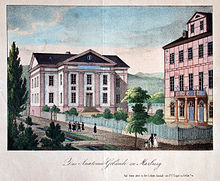Museum Anatomicum
The Museum Anatomicum ("anatomical museum") in Marburg , also called Anatomicum for short , is the medical history museum of the Philipps University of Marburg, a collection of specimens, which is based on anatomical and obstetric collections from the 19th century by scientists for teaching and research purposes has been.
history
Even Johannes Eichmann (1500–1560) carried out public examinations at the Alma Mater Philippina , the location of the Collegium medicum was the former Franciscan monastery at Barfüßertor. After the famous anatomist and naturalist Samuel Thomas Soemmerring (1755-1830) received an appointment to Mainz, the Collegium Carolinum in Kassel was dissolved in 1786 . The associated building of the Theatrum anatomicum was rebuilt on the Marburger Ketzerbach near the Elisabeth Church. Until the move to a new building at the same location in 1842, the anatomy was housed here.
Its founder, the anatomist Christian Heinrich Bünger (1782–1842), brought the basic stock of the collection of approx. 1,600 specimens with him from the disbanded University of Helmstedt to Marburg; from 1812 he was director of the anatomical institute for thirty years until his death. The collection has been expanded over time and a. expanded by Franz Ludwig Fick (1813–1858) and Friedrich Matthias Claudius (1822–1869). In 1887 Emil Gasser (1847–1919) followed his teacher Nathanael Lieberkühn (1821–1887) to the chair. The new institute building in 1902 in Untere Rosenstrasse (today Robert-Koch-Strasse ) is thanks to his appointment negotiations . During the Second World War, the anatomical institute and its exhibits were not destroyed; the collection was partially stored in the following years. Only since 1985/1989 has it been made accessible as a museum in the attic of the Pathological Institute. It now includes over 3000 exhibits from the period between 1650 and 1920. The preparations from the following years were cremated because their origin was unclear.
Departments
The museum is divided into five thematically differently oriented rooms. At the beginning, the technique of moist preparation is demonstrated over the course of time: Human exhibits that have been made durable with water, wax, various alcohols and resin, illustrate the durability of the different methods. Furthermore, wax and plaster models of human organs are presented in the entrance area.
One room contains a "racial skull collection" intended to demonstrate phrenological differences between the various ethnic groups; In addition, you will find death masks and skulls of special people such as executed criminals, which were measured craniometrically .
The next section shows a collection of animal and human skeletons for comparison between species. Abnormalities are exemplified there by human skeletons deformed by rickets, fractures or scoliosis and animal skeletons with malformations such as multiple limbs.
In the embryology department, visitors can look at specimens from early childhood malformations (so-called abortions) such as spina bifida , double formations or water heads.
A separate room is dedicated to the history of obstetrics , in which the development of obstetric equipment is documented. The “ Marburger Lenchen ”, a whole-body preparation of a heavily pregnant woman, is also located here.
In the hallway of the collection, the consequences of diseases on the human body are illustrated; the skull of a syphilis patient is exhibited here as well as the 2.44-meter-tall skeleton of tall Anton , who suffered from a pituitary gland tumor . A separate showcase is filled with preparations on the morphology of the inner ear.
Christian Heinrich Bünger , the founder of the extensive collection, was given his own room, in which, in addition to hippopotamus skulls, a wide variety of human preparations, Bünger's preparation tools and preserved tattooed skin can be seen. The skull and heart of Bünger are also part of the anatomical collection, but are not currently on display.
literature
- ddp: Insight into the complex structure of the body . In: Gießener Allgemeine . No. 52 , March 3, 2009, p. 29 .
- Kornelia Grundmann, Gerhard Aumüller (Hrsg.): The Marburg Medical History Museum Anatomicum. History and exhibition objects (= Marburger Stadtschriften zur Geschichte und Kultur 98), Marburg 2012.
- Eckart Roloff and Karin Henke-Wendt: Fascinating insights into the human being. (Museum Anatomicum - Medical History Museum of the University of Marburg) In: Visit your doctor or pharmacist. A tour through Germany's museums for medicine and pharmacy. Volume 2, Southern Germany . Verlag S. Hirzel, Stuttgart 2015, pp. 203-205, ISBN 978-3-7776-2511-9 .
Web links
- The Museum anatomicum on the website of the Medical Faculty of the Philipps University of Marburg
- The Museum Anatomicum on thieme.de
Coordinates: 50 ° 48 ′ 58.1 ″ N , 8 ° 46 ′ 16 ″ E
